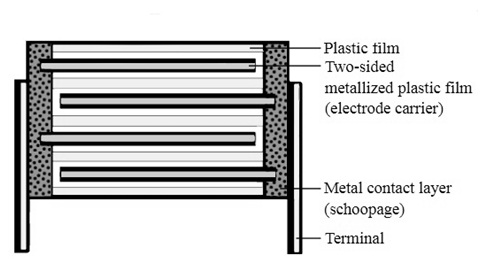A film capacitor is an electronic component that stores electrical energy in a dielectric film, which is typically made of plastic or polymer materials. The capacitor consists of two metal plates, or electrodes, that are separated by the dielectric film. When a voltage is applied across the plates, an electric field is created in the dielectric, which stores electrical energy.
The capacitance of a film capacitor is determined by several factors, including the surface area of the metal plates, the distance between the plates, and the dielectric constant of the dielectric film. The dielectric constant is a measure of the ability of the dielectric material to store electric charge. The higher the dielectric constant, the greater the capacitance of the capacitor.
Features of Film Capacitors
Some key features of film capacitors are:
- High dielectric strength: Film capacitors have high dielectric strength, which allows them to withstand high voltage levels without breaking down.
- Low dielectric loss: Film capacitors have low dielectric loss, which means that they do not generate heat when operating and have low energy dissipation.
- High insulation resistance: Film capacitors have high insulation resistance, which makes them suitable for applications where high levels of electrical insulation are required.
- Stable capacitance: Film capacitors have stable capacitance over a wide range of frequencies and temperatures, making them suitable for use in precision applications.
- Low ESR: Film capacitors have low Equivalent Series Resistance (ESR), which means that they have low impedance and can handle high-frequency signals without introducing distortion.
- Non-polarized: Some types of film capacitors are non-polarized, which means that they can be connected to a circuit in either direction without affecting their performance.
Working of Film Capacitors
A film capacitor works by storing electrical energy in the dielectric film between two metal plates. When a voltage is applied across the plates, an electric field is created in the dielectric film, which stores the electrical energy. The capacitance of the film capacitor is determined by the surface area of the metal plates, the distance between the plates, and the dielectric constant of the dielectric film.

Types of Film Capacitors
There are several types of film capacitors, each with their own unique characteristics and applications. Here are some of the most common types of film capacitors:
- Polyester Film Capacitors
- Polypropylene Film Capacitors
- Polycarbonate Film Capacitors
- Metalized Film Capacitors
- Polystyrene Film Capacitors
- Polyphenylene Sulphide Film Capacitors
- Polyethylene Terephthalate Film Capacitors
Polyester Film Capacitors
Polyester film capacitors, also known as Mylar capacitors, are one of the most widely used types of film capacitors. They are made of a thin polyester film coated with a thin layer of metal on both sides. The metal coating is typically made of aluminum or zinc. These capacitors have a low cost, low leakage current, and are suitable for general-purpose applications.
Polypropylene Film Capacitors
Polypropylene film capacitors are made of a polypropylene film as the dielectric. They have high insulation resistance, low dielectric loss, and are capable of withstanding high voltage and high temperature. These capacitors are commonly used in high-frequency and high-power applications such as switching power supplies and audio equipment.
Polycarbonate Film Capacitors
Polycarbonate film capacitors are made of a polycarbonate film as the dielectric. They have a high dielectric constant and are suitable for high-frequency and high-temperature applications. They have low leakage current, good stability, and are widely used in power supplies, audio equipment, and telecommunications.
Metalized Film Capacitors
Metalized film capacitors are made of a thin metal coating on one or both sides of the dielectric film. The metal coating serves as the electrode, and the dielectric film is wound into a cylindrical shape. These capacitors have high capacitance values, low ESR (Equivalent Series Resistance), and low self-inductance. They are used in high-frequency applications, such as RF filters and resonant circuits.
Polystyrene Film Capacitors
Polystyrene film capacitors are made of a polystyrene film as the dielectric. They have a high dielectric constant, low dielectric loss, and low temperature coefficient. They are used in applications that require high stability, such as analog circuits, audio equipment, and precision instrumentation.
Polyphenylene Sulphide Film Capacitors
Polyphenylene sulphide film capacitors are made of a polyphenylene sulphide film as the dielectric. They have a high temperature rating, low dissipation factor, and high insulation resistance. These capacitors are commonly used in high-temperature and high-voltage applications such as automotive, aerospace, and industrial control systems.
Polyethylene Terephthalate Film Capacitors
Polyethylene terephthalate (PET) film capacitors are made of a PET film as the dielectric. They have a low dissipation factor, low ESR, and high reliability. They are used in applications such as audio equipment, power supplies, and telecommunications.
Applications of Film Capacitors
Film capacitors are used in a wide range of electronic applications, such as:
- Power supplies: Film capacitors are used in power supplies to filter out noise and stabilize the output voltage.
- Audio equipment: Film capacitors are used in audio equipment, such as speakers and amplifiers, to filter out unwanted frequencies and provide high-quality sound.
- Lighting: Film capacitors are used in lighting applications, such as fluorescent lamps and LED lights, to improve the efficiency and lifespan of the lights.
- Motors: Film capacitors are used in motors to improve their performance and efficiency by reducing electrical noise and providing stable voltage.

